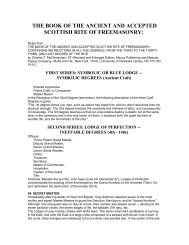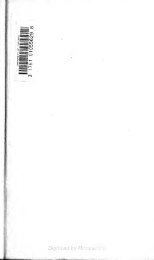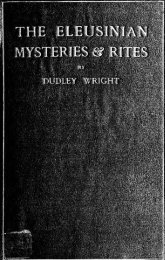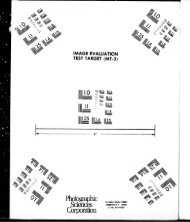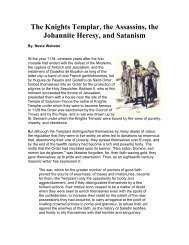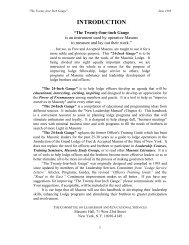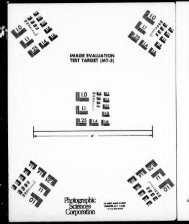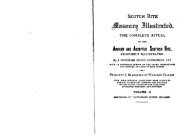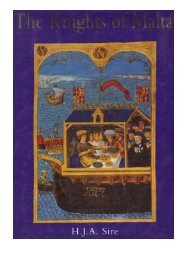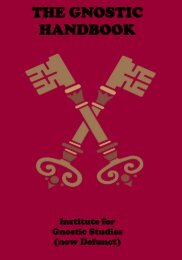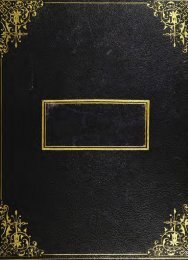The History of Initiation - The Masonic Trowel
The History of Initiation - The Masonic Trowel
The History of Initiation - The Masonic Trowel
You also want an ePaper? Increase the reach of your titles
YUMPU automatically turns print PDFs into web optimized ePapers that Google loves.
78 HISTORY OF INITIATION<br />
and represented the manner in Which the year was governed<br />
by the successive recurrence <strong>of</strong> summer and winter,<br />
or light and darkness the six ; summer, and the like<br />
number <strong>of</strong> winter months, 106<br />
also to the twelve<br />
pointing<br />
signs <strong>of</strong> the zodiac, which were emblazoned on the ro<strong>of</strong><br />
<strong>of</strong> the Mithratic cavern. <strong>The</strong> mysterious emblem which<br />
served to typify these perpetual contests for superiority<br />
l(f7<br />
was, two serpents contending for an egg, m the former<br />
being' symbolical <strong>of</strong> the powers <strong>of</strong> light and darkness,<br />
and the latter <strong>of</strong> the world. 109<br />
On these legends many wild and improbable fictions<br />
were engrafted. <strong>The</strong> Archimagus related to the initiated<br />
how the world had been seven times created and destroyed;<br />
110 how Simorgh, the omniscient griffin, 111 who had<br />
106 Thus every month was under the peculiar guardianship <strong>of</strong> a<br />
genius, from whom it received its name ; (Rich. Dissert., p. 183,) and<br />
a particular day <strong>of</strong> each month was dedicated to him by festal rites<br />
and ceremonies.<br />
107 <strong>The</strong> deity was frequently represented as involved in the folds<br />
<strong>of</strong> a serpent, (Mont. Ant. Supplem., p. 211,) in reference to the solar<br />
superstition, for the serpent was a symbol <strong>of</strong> the sun, and hence it<br />
was <strong>of</strong>ten depicted in the form <strong>of</strong> a ring with its tail in its mouth, as<br />
a striking emblem <strong>of</strong> the immortality <strong>of</strong> the deity, for whom this<br />
reptile was <strong>of</strong>ten substituted. Much may be seen on this subject in<br />
Signs and Symbols, Lect. 2.<br />
108<br />
Vid. Montfauc. 1'Antiq. Expl., torn, ii., p. 2, where is a plate <strong>of</strong><br />
this emblem, which has been copied by Maurice into the fourth<br />
volume <strong>of</strong> his Indian Antiquities.<br />
109 Calmet says, that the Persians " <strong>of</strong>fered sacrifices <strong>of</strong> thanksgiving<br />
to Oromazes ; and to Ahrimanes sacrifices to avert misfor-<br />
?<br />
tunes. <strong>The</strong>y took an herb called Omomi, which they bruised in a<br />
mortar, invoking at the same time the god <strong>of</strong> hell and darkness ; they<br />
mingled with it the blood <strong>of</strong> a wolf which they had killed, and carried<br />
this composition to a place where the rays <strong>of</strong> the sun never entered,<br />
here they threw it down and left it." (Diet, in v. Demons.)<br />
u<br />
Orient. Coll., vol. i., p. 119. This doctrine is set forth in an<br />
ancient Persian book, called the Desatir, which has been recently<br />
discovered and translated into English.<br />
"In the beginning <strong>of</strong> each<br />
Grand Period, a new order <strong>of</strong> things commenceth in the lower world.<br />
And, not, indeed, the very forms, and knowledge and events <strong>of</strong> the<br />
Grand Period that hath elapsed, but others precisely similar to them<br />
will again be produced. And every grand period that cometh, resembleth<br />
from beginning to end the grand period that is past. At<br />
the conclusion <strong>of</strong> a grand period, only two persons are left in the<br />
world, one man and one woman ; all the rest <strong>of</strong> mankind perish : and<br />
hence mankind derive their origin from the woman and man who sur-<br />
vive, and from whose loins numbers issue in the new grand period."<br />
(Book <strong>of</strong> Abad, and Commentary.)<br />
111<br />
Rich. Dissert., p. 170. "In Mr. Fox's collection <strong>of</strong> Persic



